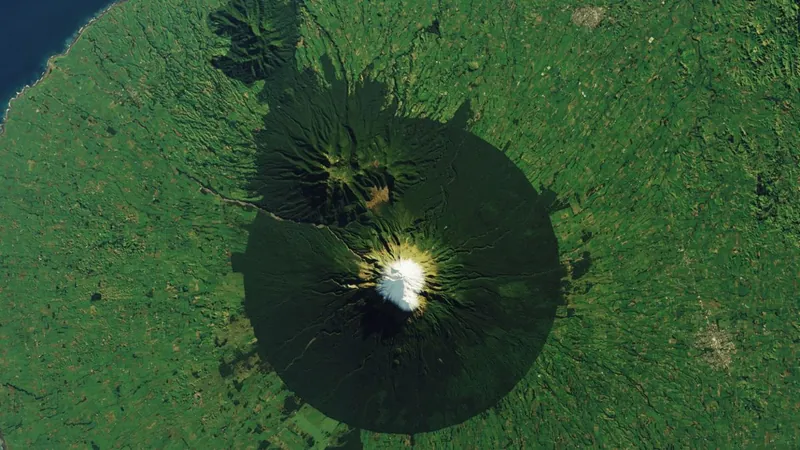
Discover the Mystifying 'Goblin Forest' Enveloping Sacred Mount Taranaki in New Zealand
2024-11-19
Author: Emily
Introduction
A breathtaking satellite image captured by Landsat 8 on June 10, 2023, reveals an astonishing sight: the majestic, snow-capped peak of Mount Taranaki emerging from a uniquely circular woodland known as the "Goblin Forest." Located in Egmont National Park, New Zealand, this stunning visual highlights not only the beauty of nature but also the deep cultural significance of the land.
Mount Taranaki: The Sacred Volcano
Mount Taranaki, historically referred to as Mount Egmont by British explorer James Cook, is an active stratovolcano on the west coast of New Zealand's North Island. Towering at approximately 8,261 feet (2,518 meters), it is the second-highest peak in the country, following Mount Ruapehu, which, standing at 9,177 feet (2,797 m), famously portrayed Mount Doom in the "Lord of the Rings" films.
The Goblin Forest Unveiled
Surrounding Mount Taranaki is Egmont National Park, spanning roughly 12 miles (19 kilometers) at its widest point. The park boasts a stunning array of dark green forests primarily composed of two large evergreen species: rimu (Dacrydium cupressinum) and kāmahi (Pterophylla racemosa). The section of the forest known as the "Goblin Forest" captivates visitors and viewers alike due to its bizarre, twisted trees shaped by centuries of volcanic activity. This unsettling landscape owes its unique appearance to the fossilized remains of trees from previous volcanic eruptions, compelling the kāmahi trees to grow in contorted manners. These flora are often draped in moss and liverworts, giving them an otherworldly, spooky quality.
Cultural Significance and Legal Rights
Adding to the significance of Mount Taranaki is its revered status among local Māori tribes, who view the volcano as an ancestor and a family member. In a landmark decision in 2017, the New Zealand government granted Mount Taranaki the same legal rights as a person, recognizing its sacredness and the indigenous people’s relationship with it. According to the Earth Observatory, this means that any harm done to the mountain carries legal implications akin to harming a tribal member.
Historical and Cinematic Connections
Notably shaped like a perfect cone, Mount Taranaki has attracted attention not only for its natural beauty but also for its cinematic appeal. Its symmetry drew filmmakers to use it as a stand-in for Japan's iconic Mount Fuji in the 2003 film "The Last Samurai." However, the appearance of the volcano has altered dramatically over time, with a 2021 study indicating at least 16 significant changes to its structure since its formation about 135,000 years ago.
Conclusion
The satellite image of Mount Taranaki rising above the eerie, goblin-like forest serves not just as a visual feast but as a reminder of the intricate relationship between nature and culture. This renowned landmark is a fascinating blend of geological history and spiritual significance, attracting visitors from around the world to witness its haunting yet beautiful charm. Whether you're a nature enthusiast, a traveler, or someone intrigued by local lore, Mount Taranaki and its Goblin Forest present a unique story waiting to be discovered.









 Brasil (PT)
Brasil (PT)
 Canada (EN)
Canada (EN)
 Chile (ES)
Chile (ES)
 España (ES)
España (ES)
 France (FR)
France (FR)
 Hong Kong (EN)
Hong Kong (EN)
 Italia (IT)
Italia (IT)
 日本 (JA)
日本 (JA)
 Magyarország (HU)
Magyarország (HU)
 Norge (NO)
Norge (NO)
 Polska (PL)
Polska (PL)
 Schweiz (DE)
Schweiz (DE)
 Singapore (EN)
Singapore (EN)
 Sverige (SV)
Sverige (SV)
 Suomi (FI)
Suomi (FI)
 Türkiye (TR)
Türkiye (TR)